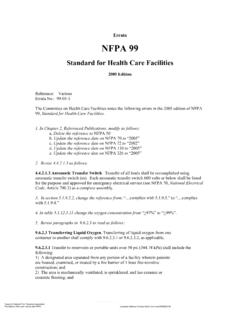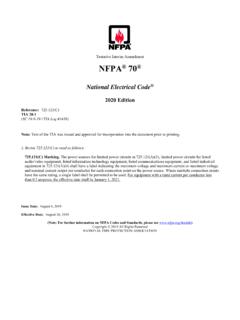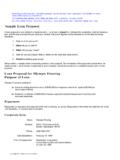Transcription of Yemen: Civil War and Regional Intervention
1 Yemen: Civil War and Regional Intervention Updated November 23, 2021 Congressional Research Service R43960 Congressional Research Service SUMMARY Yemen: Civil War and Regional Intervention For over a decade, the Republic of Yemen has been torn apart by multiple armed conflicts to which several internal militant groups and foreign nations are parties. Collectively, these conflicts have eroded central governance in Yemen and have fragmented the nation into various local centers of power. The gradual dissolution of Yemen s territorial integrity has alarmed the United States and others in the international community. Policymaker concerns include fears that state failure may empower Yemen-based transnational terrorist groups; destabilize vital international shipping lanes near the Bab al Mandab strait (also spelled Bab al Mandeb, Bab el Mendeb); and provide opportunities for Iran to threaten Saudi Arabia s borders.
2 Beyond geo-strategic concerns, the collapse of Yemeni institutions during wartime has exacerbated poor living conditions in what has long been the most impoverished Arab country, leading to what is now considered one of the world s worst humanitarian crisis. This report provides information on these ongoing and overlapping crises. In 2014, the northern Yemeni-based Ansar Allah/Houthi movement (referred to in this report as the Houthis ) took over the capital, Sana a (also commonly spelled Sanaa), and in early 2015, advanced southward from the capital to Aden on the Arabian Sea. In March 2015, after Yemeni President Abdu Rabbu Mansour Hadi, who had fled to Saudi Arabia, appealed for international Intervention , Saudi Arabia assembled a coalition of several of its Arab partners (referred to in this report as the Saudi-led coalition ) and launched a military offensive aimed at restoring Hadi s rule and dislodging Houthi fighters from the capital and other major cities.
3 Since then, the conflict in Yemen has killed tens of thousands, caused significant humanitarian suffering, and has significantly damaged the country s infrastructure. One and European-funded organization, the Armed Conflict Location & Event Data Project (ACLED), estimates as of October 2021 that more than 145,000 Yemenis have been killed since 2015. Although media coverage of the Saudi-led Intervention has characterized the war as a binary conflict (the Saudi-led coalition versus the Houthis), there actually have been a multitude of combatants whose alliances and loyalties have been somewhat fluid. In summer 2019 in southern Yemen, long-simmering tensions between the internationally recognized Republic of Yemen government (ROYG) and the separatist Southern Transitional Council (STC) boiled over, leading to open warfare between the local allies of Saudi Arabia and the United Arab Emirates.
4 Since then, periodic clashes have continued, though both sides finally implemented a power sharing agreement at the end of 2020 and formed a tenuous coalition government. Since early 2020, Houthi forces have continued to launch attacks against the ROYG in Marib governorate. The Marib governorate is the last northern stronghold of the ROYG. During summer and fall 2021, momentum shifted in favor of the Houthis, as their fighters have gradually attempted to encircle Marib city, the governorate s eponymous capital. Between September and October 2021, the Houthis captured five districts in the governorates of Marib and Shabwa, effectively cutting off the southern road linking Marib City to Shabwa a key route for the resupply of ROYG forces.
5 The Houthis have made significant territorial gains in Marib and may be on the cusp of forcing ROYG forces to surrender or negotiate a cease-fire. Many foreign observers have denounced human rights violations that they charge have been committed by all parties to the conflict. In the United States and some European countries, there has been vociferous opposition to Saudi-led coalition air strikes that hit civilian targets, leading Congress to debate and enact some legislation to limit support for the coalition. Some in Congress opposed to such efforts have highlighted Iran s support for the Houthis as a major factor in Yemen s destabilization. For several years, Yemen has been considered one of the worst humanitarian crises in the world, and public health experts warn that the Coronavirus Disease 2019 (COVID-19) pandemic is having significant negative effects on Yemen s vulnerable population.
6 To date, most humanitarian agencies believe that the extent of the outbreak in Yemen has been underreported. For additional information on Yemen, including a summary of legislation under consideration in the 117th Congress, please see CRS Report R45046, Congress and the War in Yemen: Oversight and Legislation 2015-2021, by Jeremy M. Sharp, Christopher M. Blanchard, and Sarah R. Collins. R43960 November 23, 2021 Jeremy M. Sharp Specialist in Middle Eastern Affairs Yemen: Civil War and Regional Intervention Congressional Research Service Contents Overview .. 1 Conflict Update .. 2 The Houthi-ROYG War in the North: The Battle for Marib .. 2 Other Houthi Military 3 The Port of Hudaydah .. 5 The Maritime Blockade and Fuel Shipments into Hudaydah.
7 5 Failing Oil Tanker .. 7 The Houthi-Saudi Arabia Conflict .. 8 Peace Efforts Stall .. 9 Iranian Support to the 10 Southern Yemen: Tentative Unity between the ROYG and 11 Biden Administration 12 Yemen s Humanitarian Crisis .. 14 Food Insecurity & Humanitarian Access .. 15 The COVID-19 Pandemic in 16 International Pledges for Yemen .. 17 Conflict Analysis .. 17 Figures Figure 3 Figure 2. Lines of Control in 4 Figure 3. Monitors in Hudaydah .. 5 Figure 4. Saudi-led Coalition Air Strikes per Month .. 9 Figure 5. World Food Programme: Emergency Dashboard Yemen .. 16 Contacts Author Information .. 19 Yemen: Civil War and Regional Intervention Congressional Research Service 1 Overview For over a decade, the Republic of Yemen has been torn apart by multiple armed conflicts to which several internal militant groups and foreign nations are Collectively, these conflicts have eroded central governance in Yemen and have fragmented the nation into various local centers of power.
8 The gradual dissolution of Yemen s territorial integrity has alarmed the United States and others in the international community. Policymaker concerns include fears that state failure may empower Yemen-based transnational terrorist groups; destabilize vital international shipping lanes near the Bab al Mandab strait2 (also spelled Bab al Mandeb, Bab el Mendeb); and provide opportunities for Iran to threaten Saudi Arabia s borders. Beyond geo-strategic concerns, the collapse of Yemeni institutions during wartime has exacerbated poor living conditions in what has long been the most impoverished Arab country, leading to what is now considered one of the world s worst humanitarian crises. Since March 2015, Saudi Arabia and members of a coalition it established have been engaged in military operations in Yemen against the Houthi movement, or Ansar Allah, which the government believes receives some material support from Iran.
9 As of November 2021, the epicenter of fighting was around the northern governorate and city of Marib, one of the last areas under the control of the internationally-recognized Republic of Yemen Government (ROYG) led by Yemeni President Abdu Rabbu Mansour Hadi. As of November 2021, Yemen remains beset by multiple armed and political conflicts which, in their totality, have crippled central governance, devastated the national economy, and exacerbated a long-standing humanitarian crisis. The Armed Conflict Location & Event Data Project (ACLED) estimates that from the start of Regional Intervention in Yemen in March 2015 until October 2021, over 145,000 Yemenis had been killed in various acts of 1 Formerly the Republic of North Yemen and the People s Democratic Republic of [South] Yemen, Yemen has been a unified republic since 1990 in which, according to Article 4 of its 2001 constitution (as amended)
10 , The people of Yemen are t he possessor and t he source of power, which t hey exercise direct ly t hrough public referendums and elect ions, or indirect ly t hrough t he legislat ive, execut ive and judicial aut horit ies, as well as t hrough elect ed local councils. In reality, from 1990 to 2012, the late President Ali Abdullah Saleh ruled t he unified Yemen cont inuously, cent ralizing power and cont rol under his auspices t hrough part nerships wit h foreign powers and local power brokers. Aft er popular uprisings swept across t he Arab world in 2011, including in Yemen, t he Gulf Cooperat ion Council (GCC) helped broker a t ransit ion plan for Yemen, which was endorsed by t he Unit ed Nat ions (see, Securit y Council Resolution 2014) and superseded the authority of Yemen s constitution.















